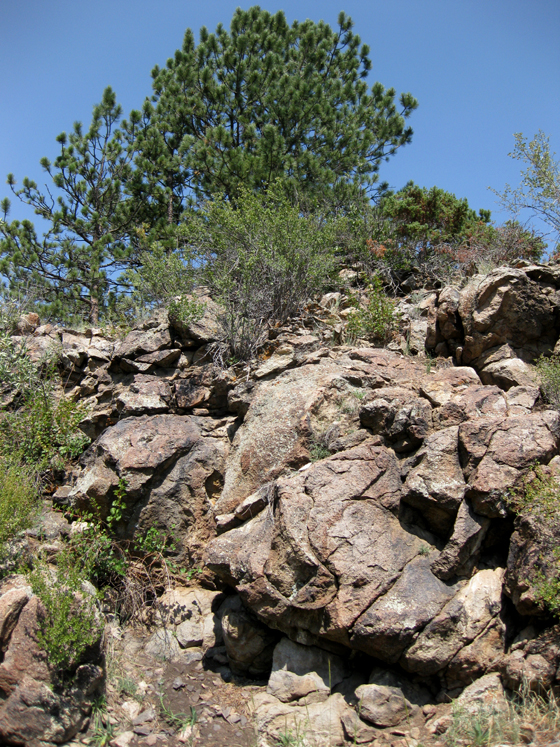
 |
 |
The
Florissant Formation: A Virtual Tour
Wall Moutain Tuff |
 Wall Mountain Tuff Exposure at Barksdale Picnic Area |
Wall Mountain Tuff The Wall Mountain Tuff, dated at 36.7 Ma, records the oldest known Paleogene volcanic activity at Florissant. An explosive volcanic eruption 80 km to the west of Florissant resulted in a pyroclastic flow--an incandescent cloud of gas and debris with temperatures of 1,000 degrees Celcius traveling at speeds of 160 km/h or more. The gasses in ash flows suspend the hot debris, which allow the volcanic material to travel as far as 120 km or more (Matthews, KellerLynn & Fox, 2003, p. 10). The pyroclastic flow followed the contours of the landscape and swept through the Florissant valley. As the flow came to rest, the hot material fused into an ignimbrite or welded rhyolitic tuff. The Wall Mountain Tuff carpeted the Florissant paleovalley and, subsequently, experienced erosion before the deposition of the Florissant Formation. Unconformities represent gaps in the sedimentary geologic record between two rock masses of different ages and indicate that the deposition of sediments was not continuous. An unconformity can represent either time during which no sediments were deposited or time during which rock layers have been eroded away. The unconformity between the Pikes Peak Granite and the Wall Mountain Tuff represents 1.04 billion years of missing time. All of the Paleozoic, Mesozoic, Paleocene and early Eocene rock units have been eroded away (KellerLynn, 2006, p. 21). Today, outcrops of the Wall Mountain Tuff appear throughout the Florissant Valley. Remnants of the Wall Mountain Tuff in Castle Rock, just south of Denver, indicate that this ancient pyroclastic flow traveled at least 150 km from the eruption site (Meyer, 2003, p. 25). Castle Rock Rhyolite is a dimensional stone made from the Wall Mountain Tuff. The gray blocks used to construct Molly Brown’s house were quarried from the Wall Mountain Tuff in Castle Rock (Mathews, KellerLynn & Fox, p. 122). Another
unconformity lies between the eroded surface of the Wall
Mountain Tuff and younger sedimentary
rock units. In most
areas the unconformity is between the Wall Mountain Tuff and
the Florissant Formation. There are some places in which the
Florissant Formation abuts laterally against the Wall Mountain
Tuff, an unusual arrangement for an unconformity. On the southeast
side of the monument it lies between the Wall Mountain Tuff
and the Tertiary boulder conglomerate. The Tertiary boulder
conglomerate contains boulders and cobbles of granite, gneiss,
schist, clasts of tuff from the Wall Mountain Tuff and fragments
of petrified wood. Streams and debris flows deposited the Tertiary
boulder conglomerate. This unconformity represents missing
time during the Eocene (Evanoff et al., 2001, p. 4; KellerLynn,
2006, p. 21 & 25). |
Bibliography |
| KellerLynn,
K. (2006). Florissant Fossil Beds National Monument Geologic
Resource Evaluation Report. Natural Resource Report NPS/NRPC/GRD/NRR—2006/009.
National Parks Service, Denver, Colorado Matthews, V., KellerLynn, K., and Fox, B. (2003). Messages in Stone: Colorado’s Colorful Geology. Canada: Colorado Geologic Survey. Meyer, H.W. (2003). The
Fossils of Florissant. Washington:
Smithsonian Books. |










